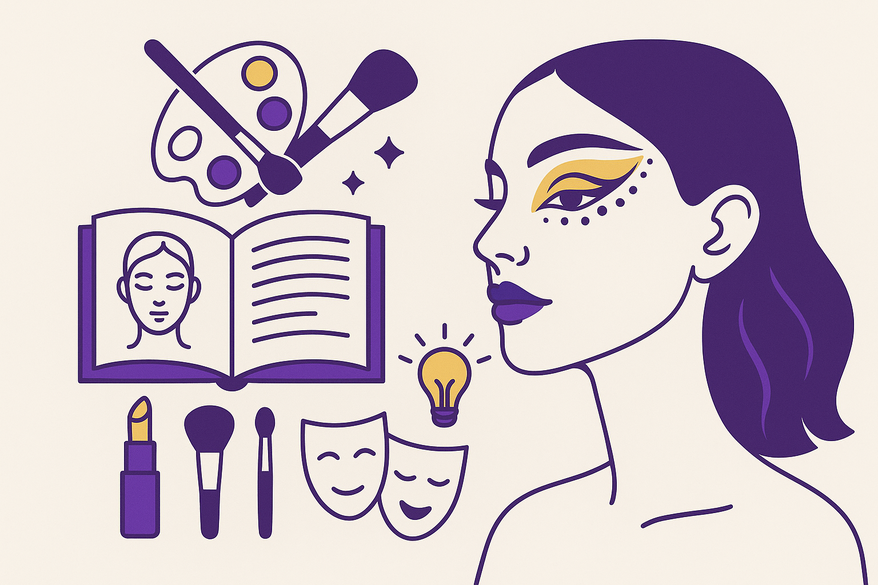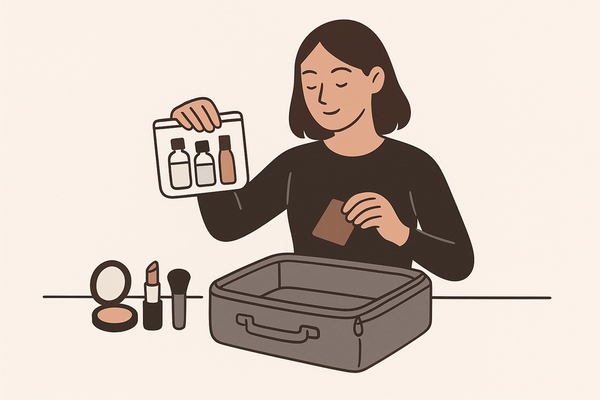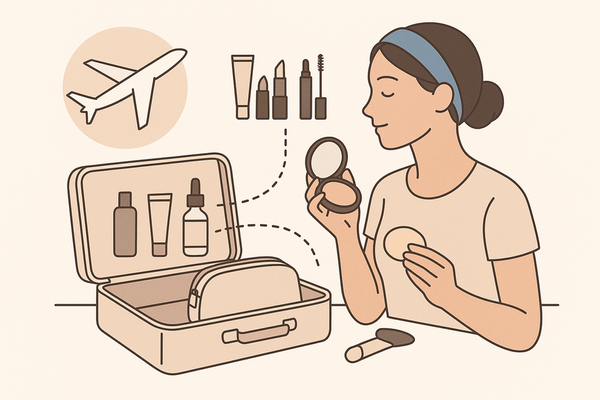The Definitive Guide to Creative Makeup Designs: Techniques, Trends & Tips
Learn everything about creative makeup designs: history, techniques, trends, and tips to transform faces into imaginative works of art.

Estimated reading time: 12 minutes
Key Takeaways
- Creative makeup transforms the face into a wearable work of art by blending fine art, theater, and avant-garde aesthetics.
- The evolution spans from ancient rituals and theatrical masks to modern social media trends.
- Essential techniques include face painting, airbrushing, layering, prosthetics, and optical illusions.
- Follow a clear workflow: inspiration, prep, base, layering, detailing, and seal.
- Current trends range from avant-garde and fantasy to pop art and minimalist abstract.
- Recommended products: highly pigmented colors, FX paints, skin-safe adhesives, quality tools, and durable setting sprays.
- Expert advice stresses sketching, mixed media experimentation, and collaboration to build credibility.
Table of Contents
- Understanding Creative Makeup Designs
- Historical Perspective and Evolution
- Exploring Various Techniques
- Step-by-Step Guidelines and How-To Insights
- Showcasing Trends and Inspirations
- Product and Material Recommendations
- Expert Advice and Industry Insights
- Conclusion
Understanding Creative Makeup Designs
Definition of Creative Makeup Designs
Creative makeup designs refer to the artistic application of cosmetics to achieve dramatic, imaginative effects—often using bold colors, unique textures, and sculptural elements, intended as wearable art. These designs push the boundaries of traditional beauty, turning the face into a canvas for personal and conceptual storytelling.
Creative vs. Traditional Makeup
- Traditional makeup focuses on subtle enhancement and tonal harmony to perfect natural features.
- Creative makeup prioritizes unexpected hues, non-traditional patterns, and mixed-media finishes over realism, often aiming for emotional impact and visual surprise.
Key Points:
- Wearable art: Makeup as fine art and expression
- Bold palettes: Neon, metallics, pastels, and dark hues
- Mixed media: Paints, glitter, gems, and prosthetics
Historical Perspective and Evolution of Creative Makeup Designs
Ancient & Theatrical Origins
- Egyptian and Asian civilizations used ritualistic and status-driven makeup, applying bold pigments and symbolic motifs.
- Early theater introduced exaggerated contours and mask-like features for stage visibility.
20th-Century Avant-Garde
- Surrealist artists like Salvador Dalí inspired editorial photographers to experiment with unusual shapes and textures.
- Fashion magazines and runway shows of the 1960s–80s showcased dramatic face art as part of avant-garde style.
Social Media Era
- Platforms like Instagram and TikTok democratized creative makeup designs, leading to viral transformations and festival looks.
- Makeup artists and hobbyists share time-lapses and tutorials, accelerating trend adoption worldwide.
Exploring Various Techniques for Creative Makeup Designs
- Face Painting – Uses water-activated paints and fine brushes to create motifs like animals, pop art, or nature scenes.
- Airbrushing – Applies ultra-fine paint particles for seamless gradients and flawless high-impact bases.
- Cosmetic Layering – Builds dimension using matte, metallic, and iridescent pigments, glitter, and adhesive gems.
- Prosthetics – Employs foam latex or silicone pieces to add 3D structures, from alien horns to scales.
- Optical Illusions – Leverages shading, line-work, and color contrast to create trompe-l’œil effects that trick the eye.
- Color, Texture & Pattern – Use color theory, mix finishes, and integrate geometric or abstract motifs.
Step-by-Step Guidelines and How-To Insights for Creative Makeup Designs
- Inspiration & Planning – Sketch your idea on paper or a face chart; choose a palette and tools.
- Prep – Cleanse, tone, moisturize, and prime for long-lasting wear.
- Base Application – Use an airbrush or full-coverage foundation in thin layers; target areas for vibrant color.
- Color & Layering – Apply pigmented paints or shadows, blend transitions, build intensity gradually.
- Texture & 3D Elements – Affix gems, foils, or prosthetics with skin-safe adhesive; let set before detailing.
- Detailing – Use fine brushes for precise line-work, shading, and optical illusions; enhance highlights.
- Set & Seal – Finish with a strong-hold spray and translucent powder; test under different lighting.
Best Practices – Work in thin layers to avoid cracking; clean brushes between colors; allocate sufficient time.
When experimenting with new looks, Makeup Check AI can act as your digital muse, offering instant design suggestions and product matches.
Showcasing Trends and Inspirations in Creative Makeup Designs
- Avant-Garde Designs – Surreal shapes and exaggerated forms with bold color blocking.
- Fantasy & Theatrical Looks – Mermaid scales, fairy dust, and mythical creature motifs.
- Pop Art Styles – Graphic outlines, vibrant hues, and comic-style dots.
- Minimalist Abstract – Geometric shapes, negative space, and limited palettes.
- Inspirational Figures – Artists like Mimi Choi and viral creators on TikTok and Instagram.
For more avant-garde inspiration and to explore AI-driven creative designs, visit our blog.
Product and Material Recommendations for Creative Makeup Designs
- Highly Pigmented Colors – Eyeshadow palettes with intense payoff; liquid pigments for full-face coverage.
- FX Paints – Cream and powder paints; water-activated pans for precise control.
- Skin-Safe Adhesives & Removers – Pros-aid for gems and prosthetics; gentle removers for skin health.
- Essential Tools – Synthetic brushes, makeup sponges, metal tweezers, and face charts.
- Setting Products – Strong-hold sprays and translucent powders for durability.
Expert Advice and Industry Insights on Creative Makeup Designs
- Professional Tips – Sketch first, experiment with mixed media, refine airbrush technique.
- Industry Impact – Editorial & runway shows set narratives; film and theater rely on 3D effects.
- Building Credibility – Collaborate with photographers; participate in challenges and competitions.
Conclusion
Creative makeup designs offer limitless possibilities for artistic expression, personal storytelling, and boundary-pushing aesthetics. We’ve covered the definition, history, techniques, trends, product picks, and expert advice to empower you on your creative journey.
Continue creating and let your face become a canvas for your imagination. And for ongoing inspiration and AI-powered beauty tools, visit Makeup Check AI.
FAQ
What is creative makeup design?
Creative makeup design is the artful application of cosmetics that goes beyond traditional beauty, using bold colors, textures, and sculptural elements to tell a visual story.
How do I plan a creative makeup look?
Start by gathering inspiration and sketching your idea on a face chart. Select a color palette, tools, and any mixed-media elements you plan to use.
Which techniques are most popular?
Face painting, airbrushing, cosmetic layering, prosthetics, and optical illusions are among the most sought-after methods for impactful designs.
What products do I need for creative makeup?
Invest in highly pigmented colors, FX paints, skin-safe adhesives, quality brushes, sponges, and a strong-hold setting spray.
How can I ensure my design lasts?
Prep skin with primer, work in thin layers, let adhesives set fully, and finish with a durable setting spray and translucent powder tested under various lighting.




